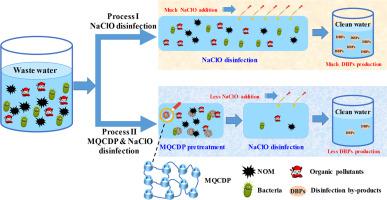当前位置:
X-MOL 学术
›
Water Res.
›
论文详情
Our official English website, www.x-mol.net, welcomes your
feedback! (Note: you will need to create a separate account there.)
Synergistic disinfection effects and reduction of disinfection by-products in water treatment using magnetic quaternized cyclodextrin polymer combined with chorine disinfection process
Water Research ( IF 11.4 ) Pub Date : 2023-12-27 , DOI: 10.1016/j.watres.2023.121078 Lin Sun 1 , Guizhou Xu 2 , Yizhou Tu 2 , Huaicheng Zhang 3 , Wenrui Zhang 2 , Xingqi Zhu 2 , Ying Liang 4 , Aimin Li 2 , Xianchuan Xie 5
Water Research ( IF 11.4 ) Pub Date : 2023-12-27 , DOI: 10.1016/j.watres.2023.121078 Lin Sun 1 , Guizhou Xu 2 , Yizhou Tu 2 , Huaicheng Zhang 3 , Wenrui Zhang 2 , Xingqi Zhu 2 , Ying Liang 4 , Aimin Li 2 , Xianchuan Xie 5
Affiliation

|
Disinfection is vital in ensuring water safety. However, the traditional chlorine disinfection process is prone to producing toxic and harmful disinfection by-products (DBPs). The combination of quaternary ammonium polymer and the chlorine disinfection process can solve this shortcoming. Currently, research on the control of DBPs through the combined process is not systematic and the control effect between reducing the dosage of disinfectants and DBPs remains to be studied. Quaternized cyclodextrin polymers have attracted increasing attention due to their excellent adsorption and antibacterial properties, but their synergistic effect with chlorine disinfection is still unclear. In this study, a magnetic quaternized cyclodextrin polymer (MQCDP) is synthesized in an ionic liquid green system, and a combined process of MQCDP treatment and chlorine disinfection is established. The disinfection performance of the combined process on the actual water body along with its reducing effect on the amount of chlorine disinfectant as well as the trihalomethanes (THMs) and haloacetic acids (HAAs) DBPs are explored. MQCDP has a porous structure with a specific surface area of 825 m2 g−1 and is easily magnetically separated. MQCDP can remove most of the natural organic matter (UV254 absorbance decreased by 97 %) in the water at the dosage of 1 g L−1 and kill bacteria with a sterilization rate of 85 %. Compared with disinfection using chlorine alone, the combined process has higher disinfection efficiency and significantly reduces the amount of disinfectant used. A concentration of 5 mg/L of NaClO was needed to meet the standard by chlorine disinfectant alone, while only 2 mg/L of NaClO can meet the standard for the combined process, indicating 60 % of the chlorine demand was reduced. More importantly, the combined process can significantly reduce the generation potential of DBPs. When 10 mg/L of NaClO is added, the THMs and HAAs generated by the combined process decreased by 65 % and 34 %, respectively, compared with the levels produced by single chlorine disinfection. The combined process can reduce the dosage of chlorine disinfectant and MQCDP can adsorb humic acid DBP precursors in raw water, thus lowering the generation of DBPs during disinfection. In summary, MQCDP has excellent separation and antibacterial ability, and its synergistic effects combined with the chlorine disinfection process are of great significance for controlling the amount of disinfectant and the formation potential of DBPs, which has potential applications in actual water treatment.
中文翻译:

磁性季铵化环糊精聚合物与氯消毒工艺相结合的水处理协同消毒效果及减少消毒副产物
消毒对于确保用水安全至关重要。然而,传统的氯消毒工艺容易产生有毒有害的消毒副产物(DBPs)。季铵聚合物与氯消毒工艺的结合可以解决这一缺点。目前,通过组合工艺控制DBPs的研究还不系统,减少消毒剂用量与DBPs的控制效果还有待研究。季铵化环糊精聚合物因其优异的吸附和抗菌性能而受到越来越多的关注,但其与氯消毒的协同作用仍不清楚。本研究在离子液体绿色体系中合成了磁性季铵化环糊精聚合物(MQDDP),并建立了MQCDP处理和氯消毒的组合工艺。探讨了联合工艺对实际水体的消毒性能及其对含氯消毒剂以及三卤甲烷(THM)和卤乙酸(HAA)DBP用量的降低效果。 MQCDP 具有比表面积为 825 m2 g−1 的多孔结构,易于磁分离。 MQCDP在1 g L−1的投加量下即可去除水中大部分天然有机物(UV254吸光度下降97%),杀灭细菌,杀菌率达85%。与单独使用氯消毒相比,联合工艺消毒效率更高,并且大大减少了消毒剂的使用量。单独使用含氯消毒剂需要5mg/L的NaClO浓度才能达标,而组合工艺只需2mg/L的NaClO即可达标,需氯量减少60%。 更重要的是,联合工艺可以显着降低DBPs的产生潜力。当添加10 mg/L NaClO时,与单一氯消毒产生的水平相比,联合工艺产生的THM和HAA分别降低了65%和34%。联合工艺可减少含氯消毒剂的用量,且MQCDP可吸附原水中腐植酸DBP前体,从而减少消毒过程中DBP的产生。综上所述,MQCDP具有优异的分离和抗菌能力,其与氯消毒工艺相结合的协同效应对于控制消毒剂量和DBPs的形成潜力具有重要意义,在实际水处理中具有潜在的应用前景。
更新日期:2023-12-27
中文翻译:

磁性季铵化环糊精聚合物与氯消毒工艺相结合的水处理协同消毒效果及减少消毒副产物
消毒对于确保用水安全至关重要。然而,传统的氯消毒工艺容易产生有毒有害的消毒副产物(DBPs)。季铵聚合物与氯消毒工艺的结合可以解决这一缺点。目前,通过组合工艺控制DBPs的研究还不系统,减少消毒剂用量与DBPs的控制效果还有待研究。季铵化环糊精聚合物因其优异的吸附和抗菌性能而受到越来越多的关注,但其与氯消毒的协同作用仍不清楚。本研究在离子液体绿色体系中合成了磁性季铵化环糊精聚合物(MQDDP),并建立了MQCDP处理和氯消毒的组合工艺。探讨了联合工艺对实际水体的消毒性能及其对含氯消毒剂以及三卤甲烷(THM)和卤乙酸(HAA)DBP用量的降低效果。 MQCDP 具有比表面积为 825 m2 g−1 的多孔结构,易于磁分离。 MQCDP在1 g L−1的投加量下即可去除水中大部分天然有机物(UV254吸光度下降97%),杀灭细菌,杀菌率达85%。与单独使用氯消毒相比,联合工艺消毒效率更高,并且大大减少了消毒剂的使用量。单独使用含氯消毒剂需要5mg/L的NaClO浓度才能达标,而组合工艺只需2mg/L的NaClO即可达标,需氯量减少60%。 更重要的是,联合工艺可以显着降低DBPs的产生潜力。当添加10 mg/L NaClO时,与单一氯消毒产生的水平相比,联合工艺产生的THM和HAA分别降低了65%和34%。联合工艺可减少含氯消毒剂的用量,且MQCDP可吸附原水中腐植酸DBP前体,从而减少消毒过程中DBP的产生。综上所述,MQCDP具有优异的分离和抗菌能力,其与氯消毒工艺相结合的协同效应对于控制消毒剂量和DBPs的形成潜力具有重要意义,在实际水处理中具有潜在的应用前景。































 京公网安备 11010802027423号
京公网安备 11010802027423号